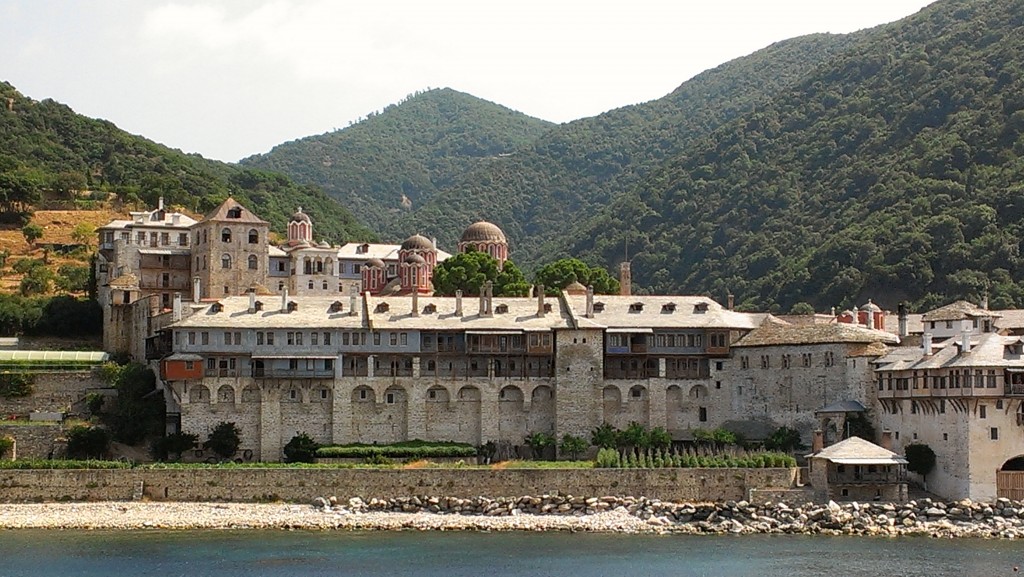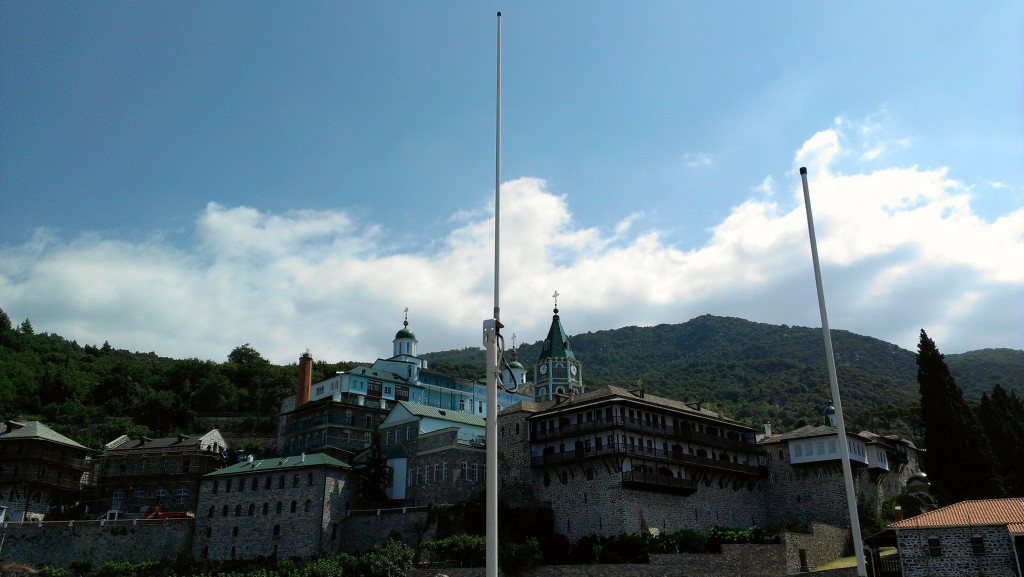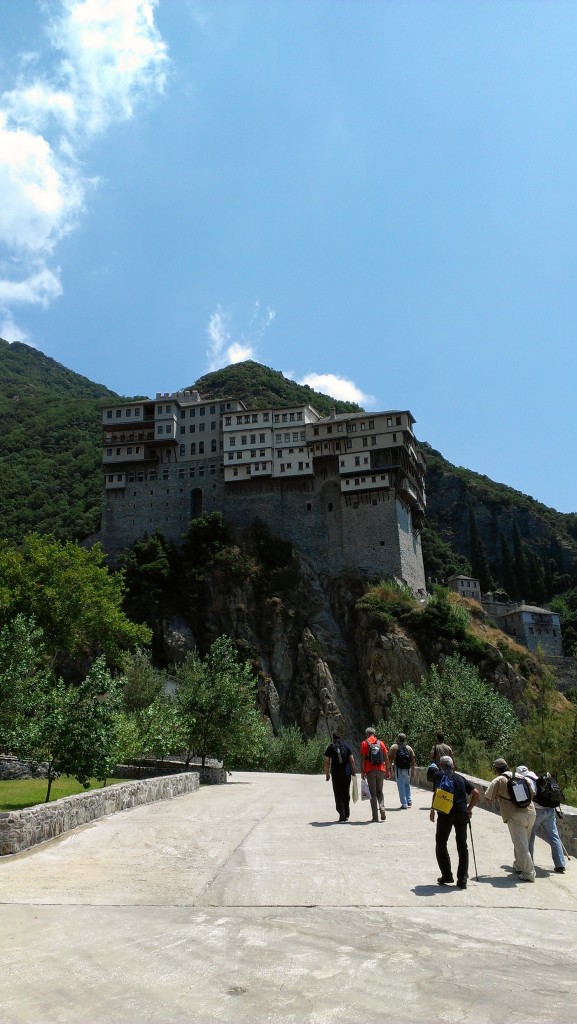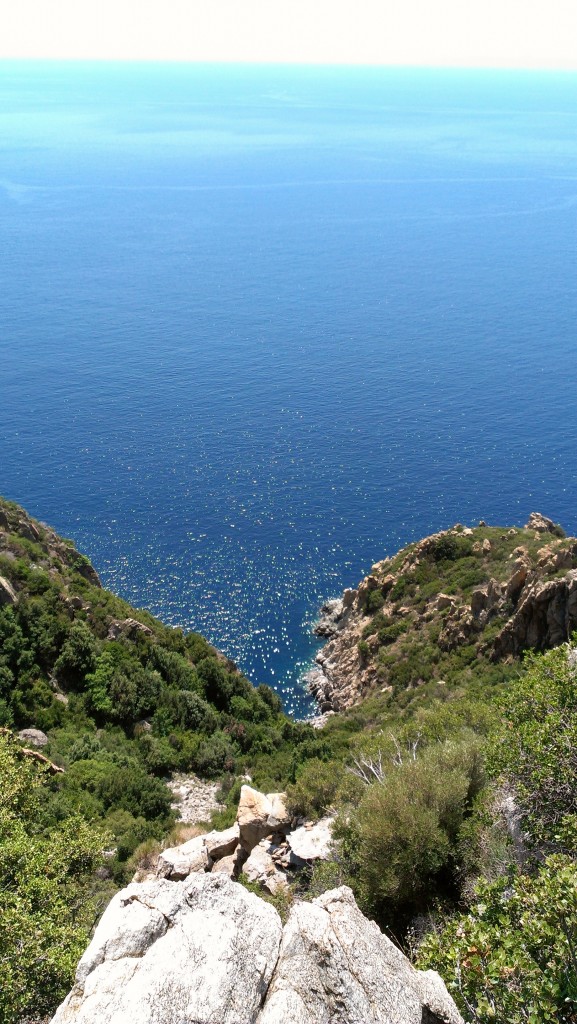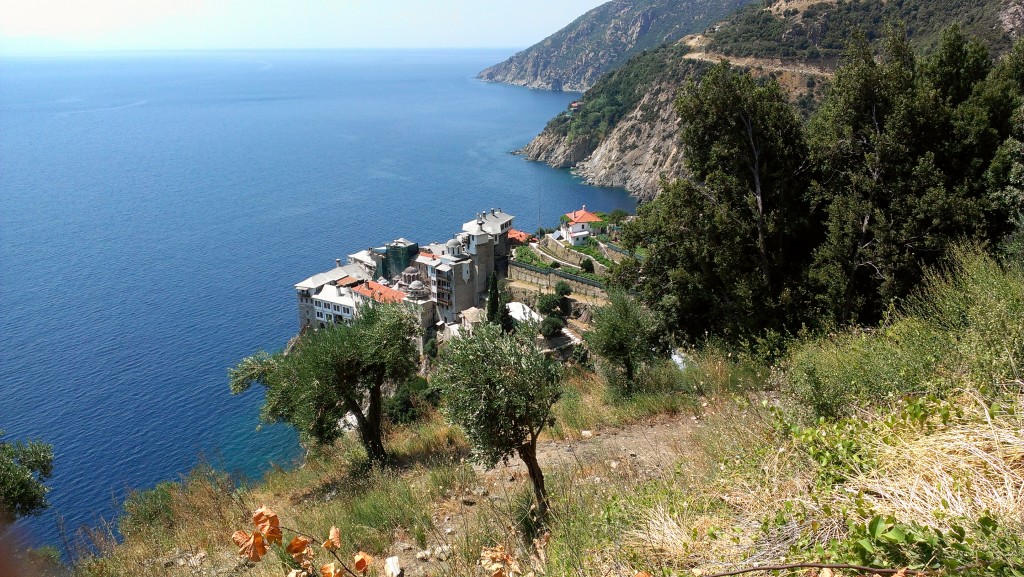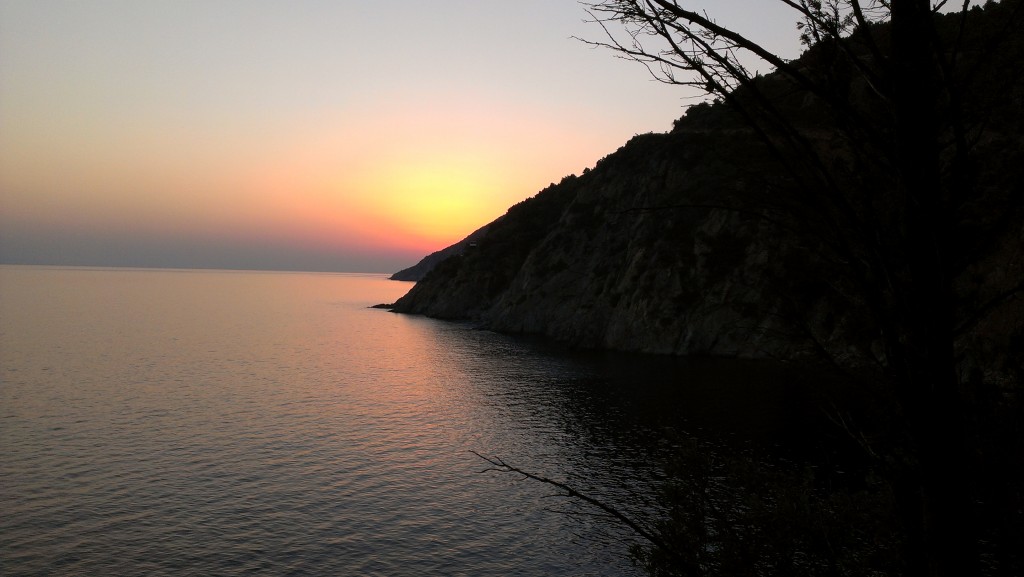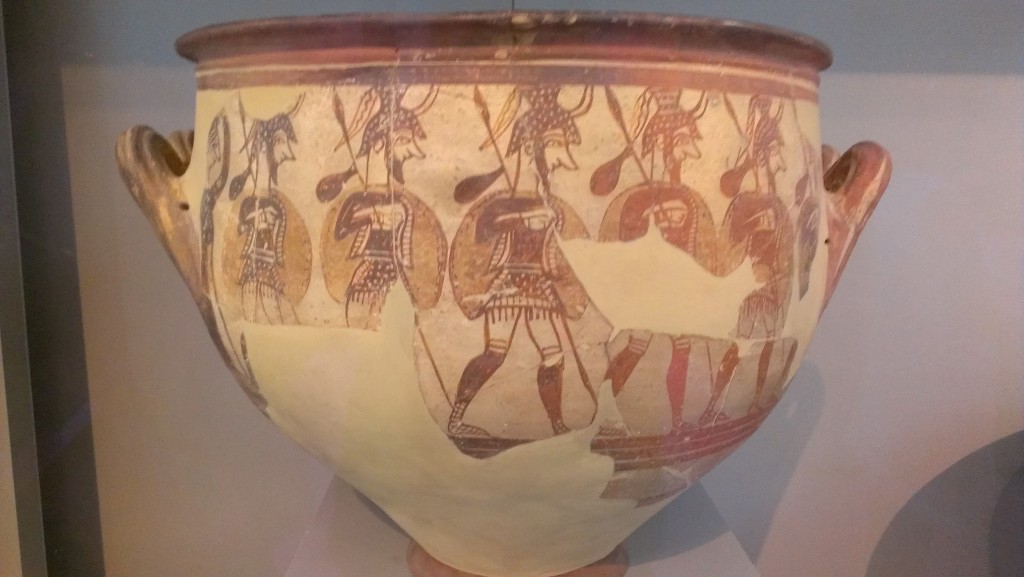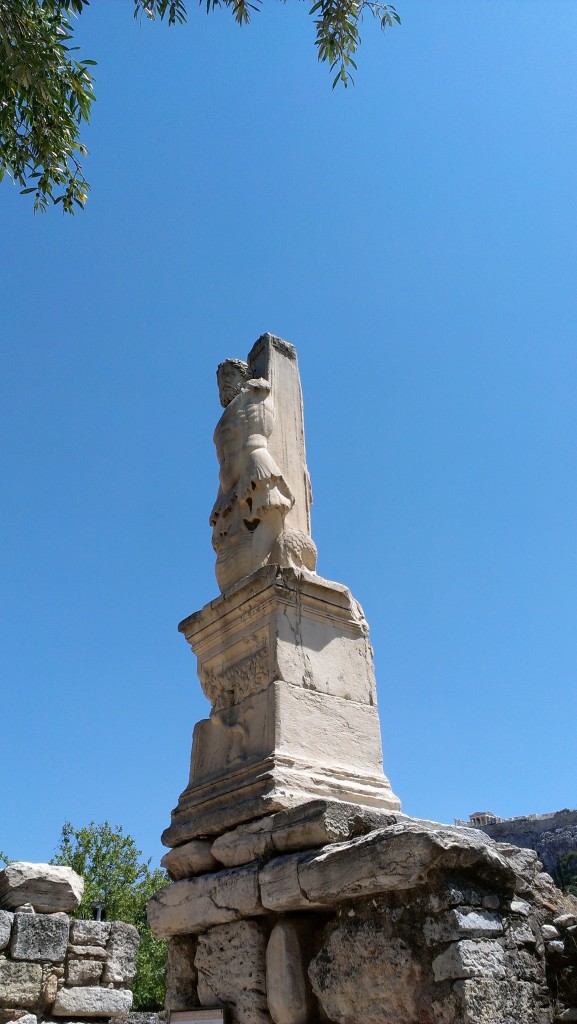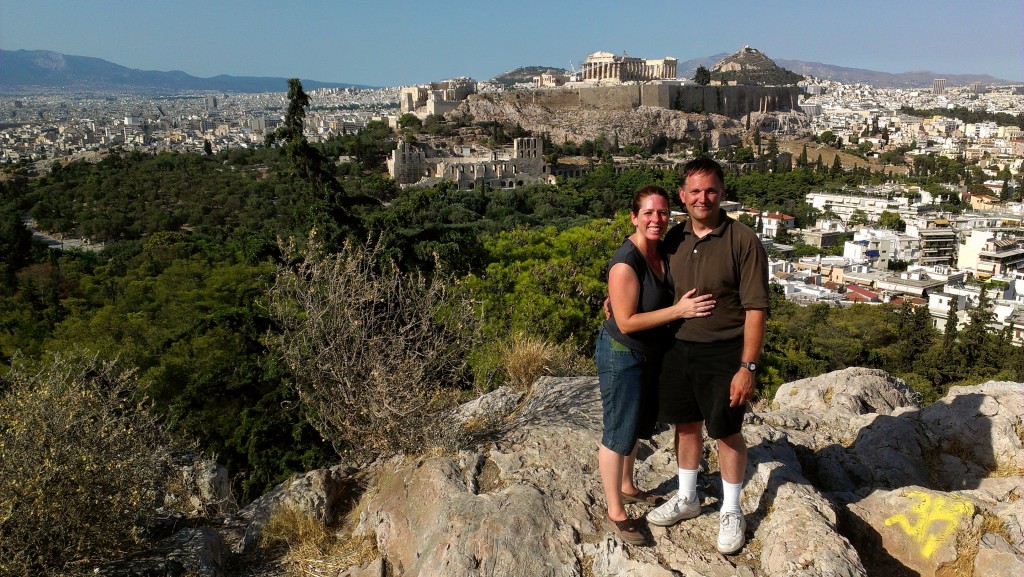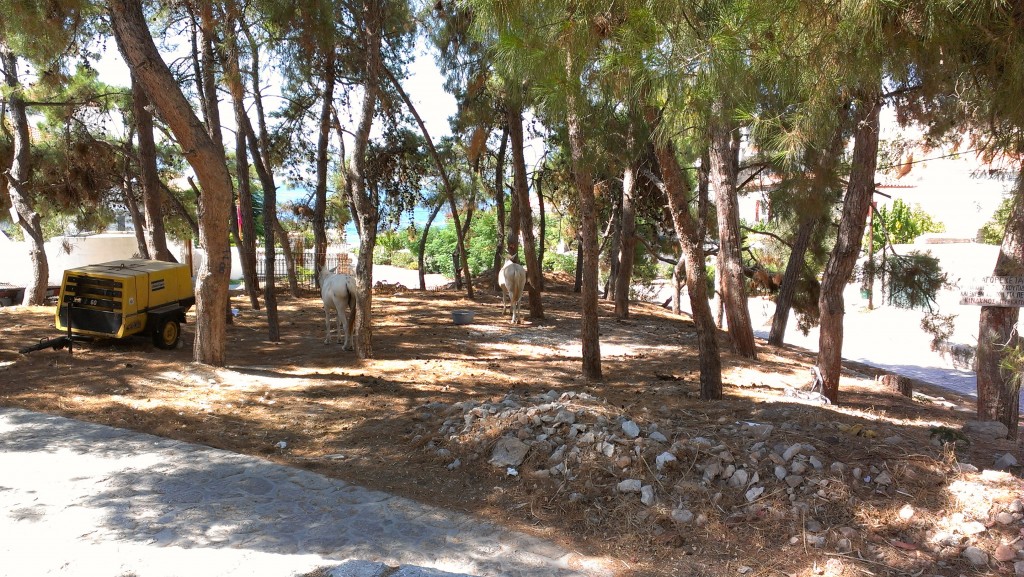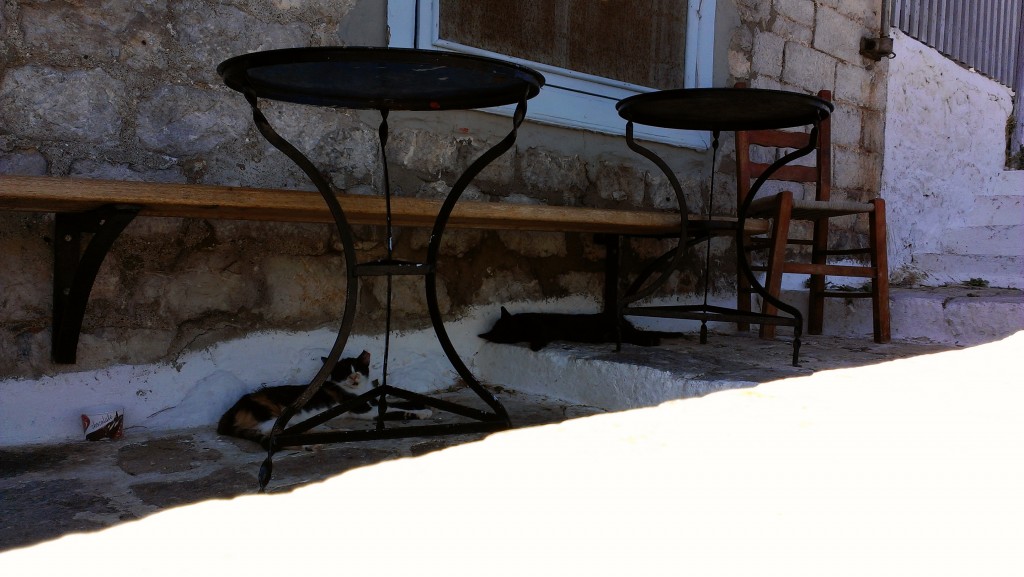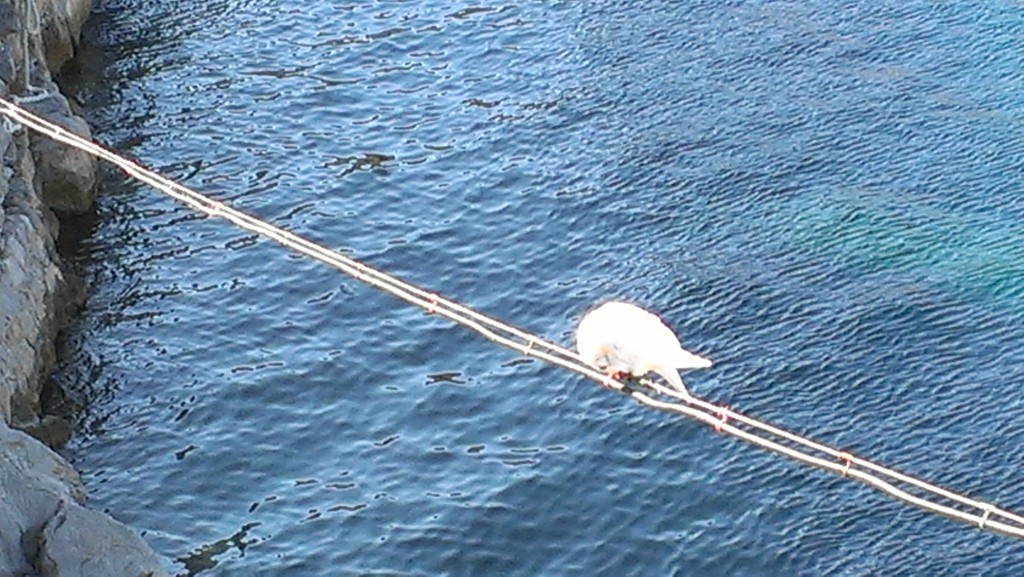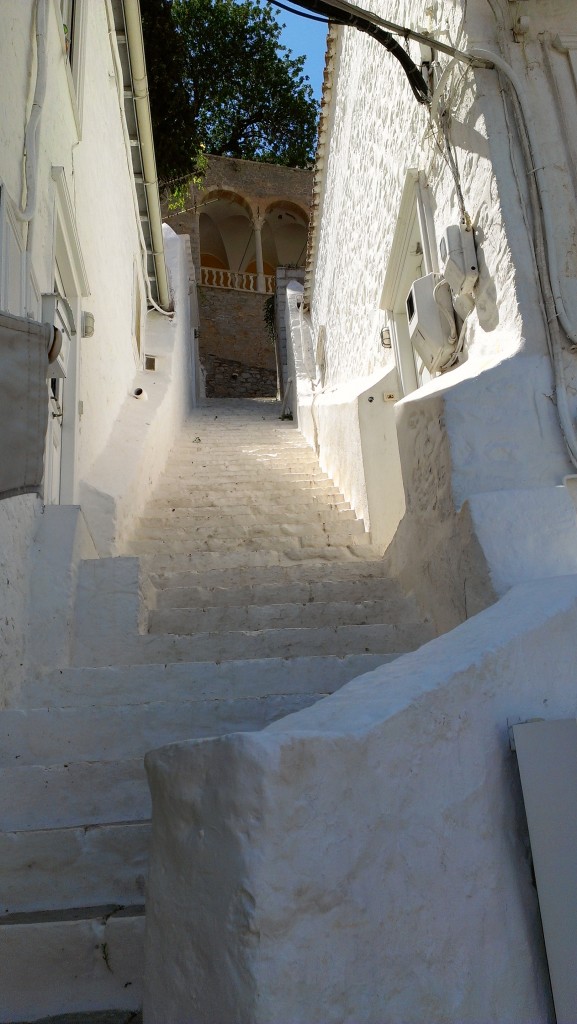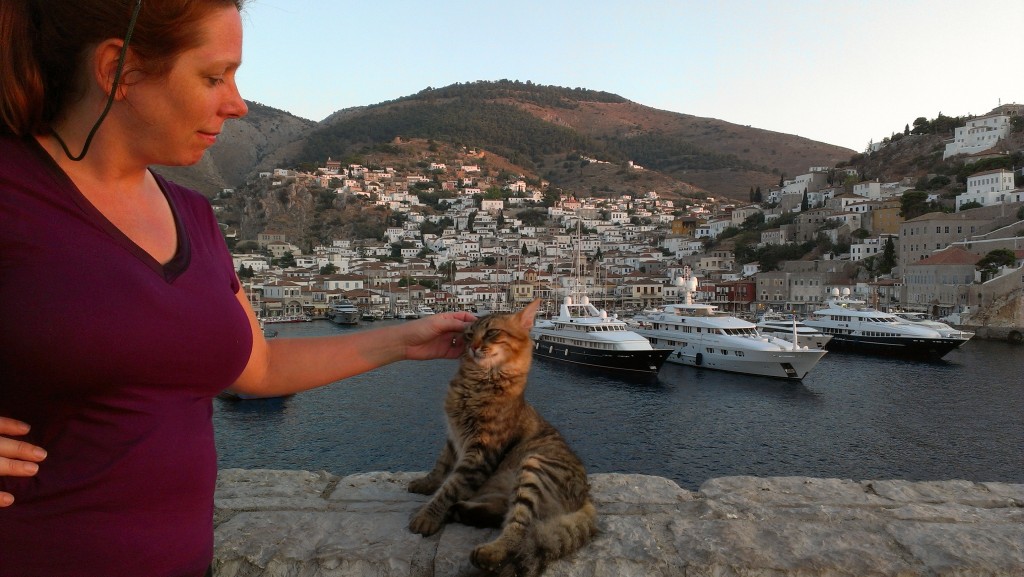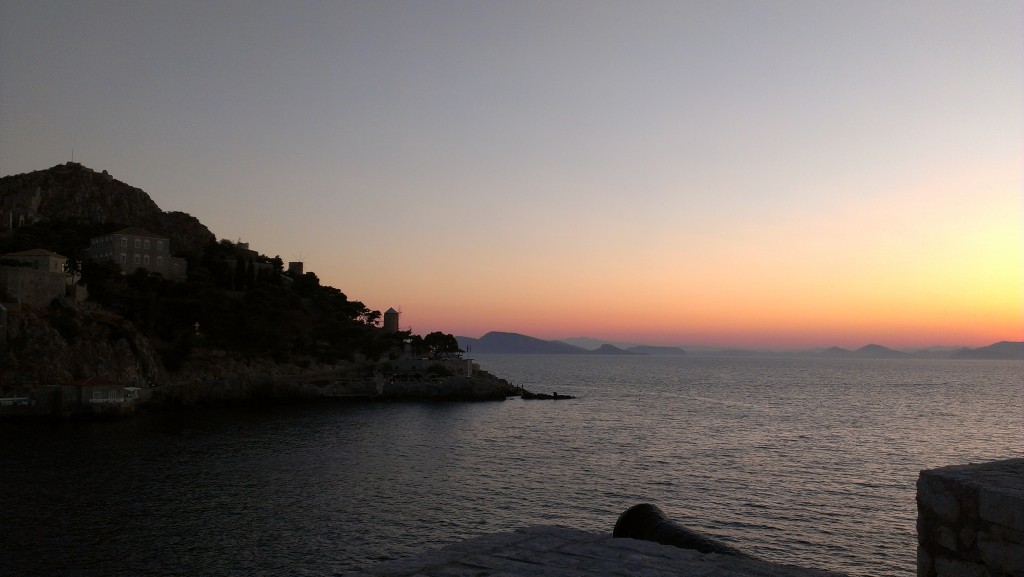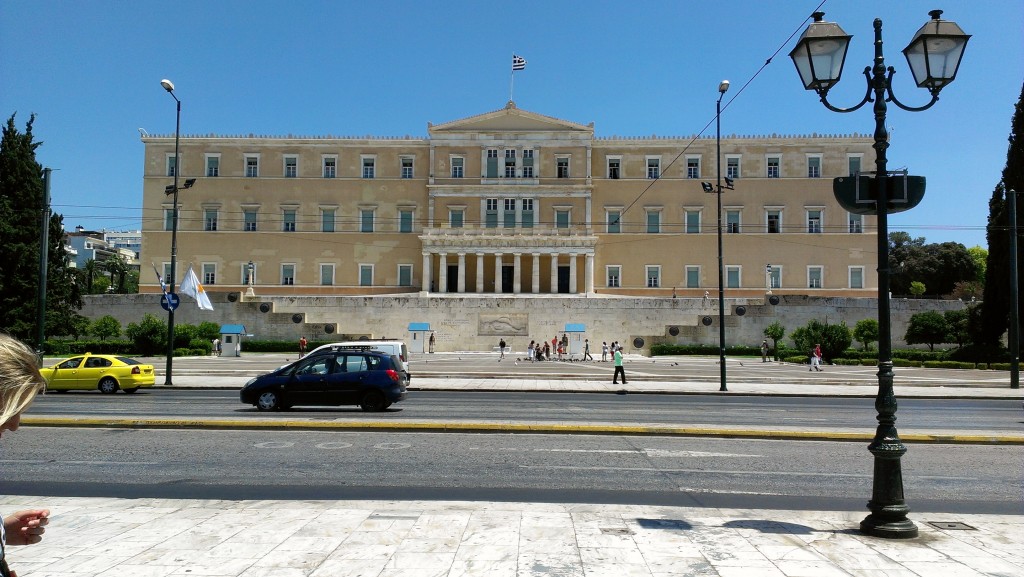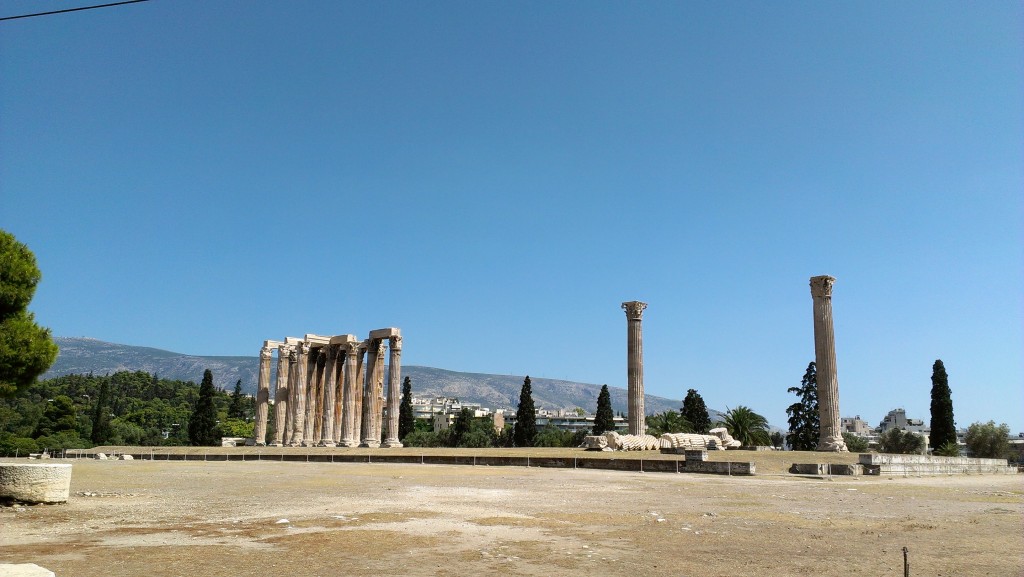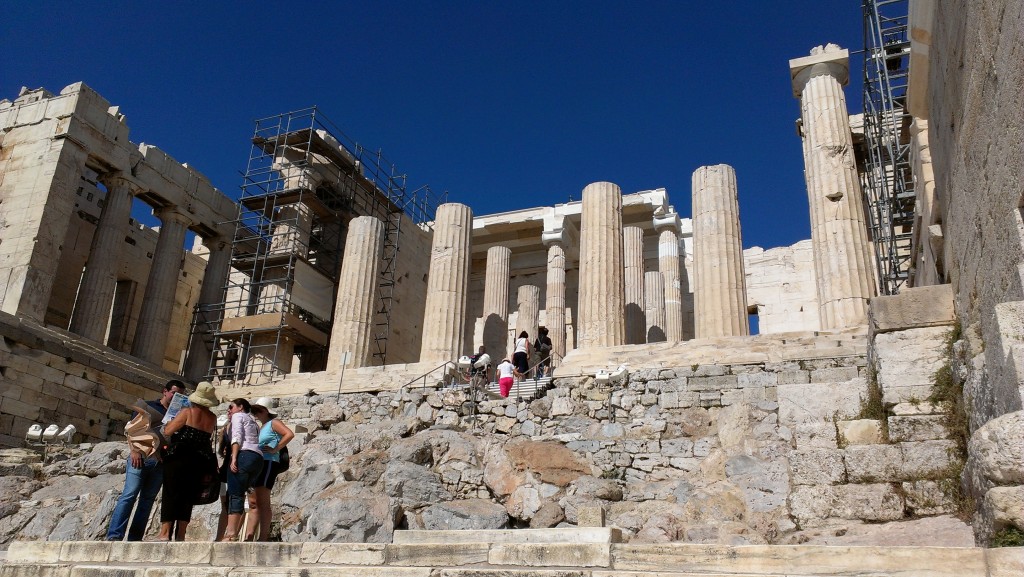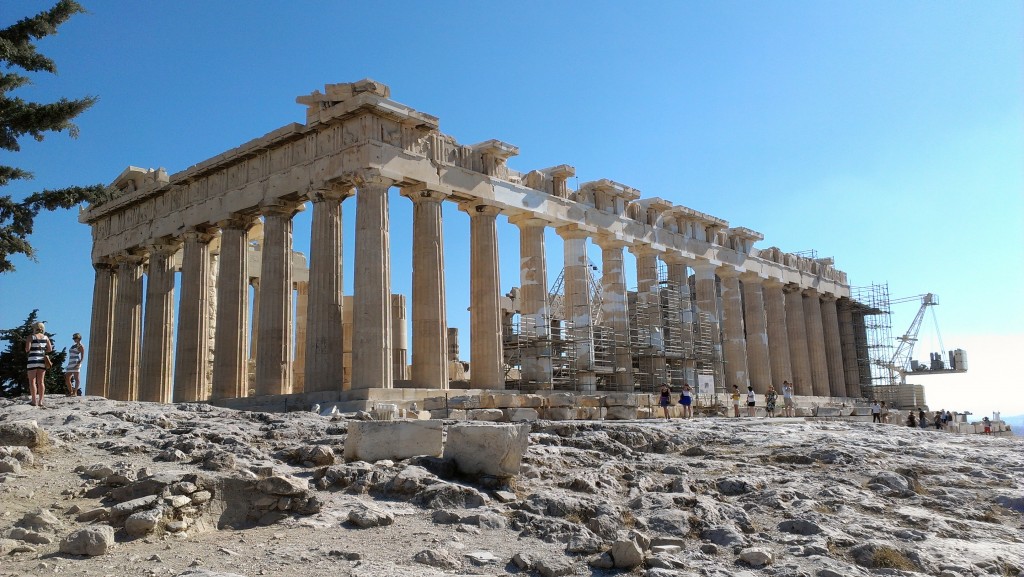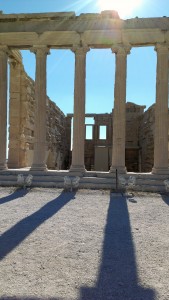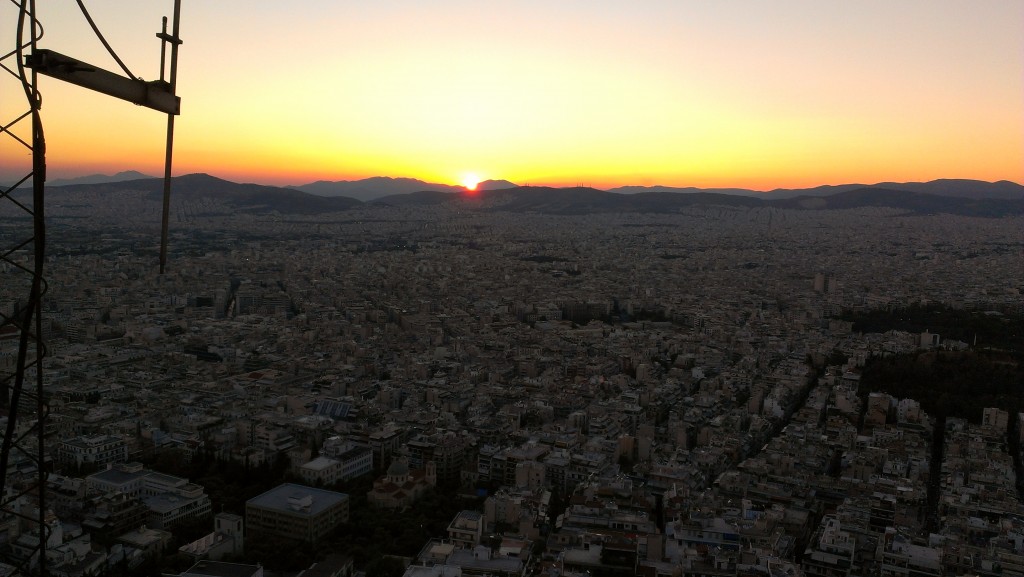For Tuesday and Wednesday, Leigh and I shall have to write separate entries, because I went off on my own. In fact, I went somewhere that Leigh couldn’t have come even if she wanted to: Mount Athos.
Mount Athos is an essentially independent country within Greece composed entirely of Orthodox monks. It’s a peninsula southeast of Thessaloniki that has been consecrated as a holy place in the Orthodox religion for over a thousand years. Also, no women have been allowed there since 1060.
In order to visit the peninsula, you need a special permit, called a diamonētērion, for which you must apply in advance, and only ten per day are issued to non-orthodox visitors. I was told that three years ago, to visit in the middle of July you would need to apply for a permit in February. I applied only two weeks before the trip and was issued one. Tourism is down due to the perceptions of the financial crisis.
Getting there was an adventure in itself. I left the hotel at 4:30 in the morning by taxi, to reach the regional bus terminal east of Thessaloniki. There’s hilarity there too: there are a number of different bus regions in Greece, all theoretically run by the same company, but they won’t coordinate with each other, and each have their own website and schedule. By bus I reached Ouranoupolis, the last stop in secular Greece.
The bus was full of other pilgrims, so we all trooped off the bus and into the pilgrims’ bureau to pick up our letters. It’s a great piece of paper – colored seals, and the facsimile signatures of the four top monks on Athos. You can’t tell from the picture, but Oranoupolis is actually a bit of a tourist trap of a beach town. So you have this odd mix of beach goers, souvenier shops, religious pilgrims, and a higher than usual number of bearded, black-clad orthodox clergy.
The only access to the peninsula is by boat, so the whole herd of us left the pilgrims’ office, and wandered down to the boat dock to buy tickets and catch the ferry to Daphni, the primary port.
The ferry proceeds down the coast, stopping at a number of monasteries before reaching Daphni. At each one, a few pilgrims and clergy got off, but the majority were waiting for the main port.
While the majority of the monasteries on Athos are Greek Orthodox, there are also individual ones for several other branches. This is the Russian Orthodox one, which has been seeing a lot of reconstruction funding lately. Construction seemed to be a big theme everywhere I went, actually – there has apparently been a bit of a resurgence of interest in the peninsula in the last decade or so.
I didn’t take a picture of Daphni itself – it’s just a dinky little collection of buildings with a cafe, a customs station, and a gift shop full of icons, incense, walking sticks, and trail maps. Also cats.
My plan was actually to do some hiking, so I caught yet another boat heading farther down the coast. I intended to go one monastery past the one where I would be spending the night, and then walk back.
This is the view from the water of Grigoriou, where I would spend the evening. Note the largish hill-type things surrounding it.
And this is Dionysiou, where I got off the boat. Note all the other men walking right up the hill to the monastery. I turned left, and discovered that the trail I had selected, a 500 year old footpath, had not been groomed recently, and by “recently,” I mean “for at least a decade.” I was wearing jeans, because it’s not considered respectful to visit the monasteries in shorts. Good thing, because I would have been cut to ribbons.
It was also an extremely grueling climb – according to the GPS, I went up about 500 feet in the first ascent, and it was very steep. It was also in the high 90s. The views were quite spectacular, however:
The Aegean was also stunningly beautiful.
However, it was about at this point that it dawned on me that no one knew where I was, that my cell phone didn’t work in this hemisphere, and that if I passed out from heat exhaustion, no one was likely to find me for weeks. The GPS kept me appraised of my location, but it was still a scary realization. (Spoiler Alert: I made it back safely.)
About two-thirds of the way along, I found a gate. A gate? What the hell? I’m certainly not going to turn around and go back at THIS point! Fortunately, the sign merely said, “Please Close The Gate Behind You.” ?!? I have no idea what the point of this gate is.
I had started the walk with a liter and a half of water, and by the time I was 80% of the way there it was already gone. This was a welcome sight, when I finally reached it:
I dragged myself to the guesthouse, and discovered – no one there! And no one answering the phone number I was supposed to dial, either. So I just sat on a bench for an hour and tried to stop shivering – heat exhaustion, I’m pretty sure.
Unfortunately, no photography is allowed in the monastery, so I couldn’t take any pictures of the beautiful church or refectory. Eventually I was collected, and sent up to the church for the pre-dinner service. I had never attended an Orthodox service before. The church has three rooms – the outer one where non-orthodox sit, the middle one, for orthodox worshipers, and an inner one where only the monks go.
The service lasted about an hour and was very confusing – monks were constantly coming and going, not just between the rooms, but out of the church entirely. Every now and then someone would wander out into the outer room with a brazier of incense or a rattle, and we’d all stand up. Arriving monks would venerate the icons in the outer room before continuing, except when they didn’t. People would come and light candles, or put them out, seemingly at random. Younger adepts would come out and prostrate themselves repeatedly in front of the icons.
The one truly memorable thing was the chanting. Orthodox polyphony is definitely more interesting to listen to than Gregorian chant, in my opinion. And since my Greek is even worse than my Latin, it’s a good thing the chanting was pleasant to listen to.
After the service ended, we all proceeded across the hall to the refectory for an excellent meal. Eating at the monastery is very quick – there’s no talking at all, because a monk is reading from scripture during the entire meal. You have about ten minutes to eat everything in front of you, because when the bell rings, whether you’ve finished or not, everyone gets up and leaves.
At the same time as I had arrived, an Irish visitor turned up who had hiked in over the much better path from the opposite direction. After dinner, the two of us were introduced to Father Damien, a London native who had spent the last twenty years at the monastery. We had a very interesting conversation in the refectory about the history and nature of the Orthodox religion. I tried to be respectful and ask neutral questions, despite not sharing his faith.
I was going to combine Day 5 and 6 into one post, but seeing as how this is already the longest post so far, I’ll break here with yet another beautiful sunset.
Statistics:
- Means of Transportation Employed: Cab, Bus, Boat
- Cumulative Total: 8
- Highest point: 173 meters
- Most difficult food to eat politely with silverware: Seeded Watermelon



